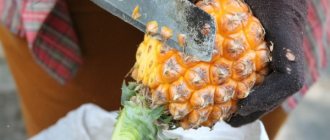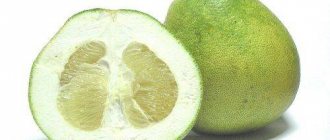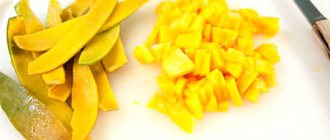Why is it so difficult to peel and cut mangoes?
The birthplace of this fruit is India. Mango is a fairly large fruit weighing 400–450 g, covered with a dense thick skin, with a large stone that is difficult to separate from the pulp. The pulp itself is very tender, juicy, fibrous. In shape it resembles an oval, slightly widening at the base and tapering towards the top.
There are many varieties of mangoes, differing in shape, size, skin color, taste
Only the pulp of mangoes is eaten. The peel is not only not healthy, but even dangerous to health. In addition to a very specific taste and hardness, it contains urushiol, an organic toxin that often causes skin allergies. For people prone to such reactions, sometimes touching the fruit is enough to cause a rash and irritation. This does not mean that they should stop eating mangoes, they just have to use thin rubber or latex gloves to peel them.
You should not eat unripe fruits either - this can lead to severe stomach upset and irritation of the respiratory tract.
Removing the pit
This is more difficult to do than it might seem: not only is the seed itself covered with hairs, the surrounding flesh is also riddled with dense fibers. And yes, it is flat.
To understand how it is located inside the fruit, you need to cut off its top from the side of the stalk. The upper part of the bone will be exposed, it will become clear how to cut further.
Experts successfully determine the location of the seed by a barely noticeable rib that runs along the fruit. By the way, you should not gnaw on the bone; it greatly harms tooth enamel.
Proceed as follows:
- without peeling the fruit, cut off the side parts of the fruit vertically, the so-called “cheeks” near the seed, the remaining center is lifted with the edge of a glass or goblet with thin walls, where the seed falls out;
- When ripe, it can be removed with a spoon, the fruit is most often not peeled, it is cut in a ring around the circumference to the very seed, a spoon is placed in the cut so as to divide the fruit into halves, the remaining seed in one of them is removed with a spoon;
- the turning method is used only for ripe fruits, they are not peeled, the cut is made in the same way as in the previous case, then the halves are turned in different directions, the exposed seed can be easily removed with the edge of a glass or a spoon;
- You can cut the fruit not only across, but also lengthwise; then proceed in the same way as in the previous case.
You can’t cut the bone, and it’s difficult to do it with a knife. If, when cutting the fruit, it encounters an obstacle, then the direction of cutting needs to be changed.
What to do with the bone? It is inedible and is thrown away, just like the peel. All that remains is to cut the pulp beautifully. This can also be done in several ways.
Read: What kind of fruit is kumquat?
Cutting methods and serving options
The most popular way to cut mangoes is with a hedgehog cut. It's easy to make and looks great on the table:
- Cut off the base of the fruit for greater stability and place it on a plate.
- From top to bottom, holding the fruit firmly, cut off both “cheeks” as close to the seed as possible. Their thickness is approximately 2–3 cm.
- Make several parallel cuts in the flesh of the “cheeks” at intervals of about 1 cm. Repeat the same thing perpendicular to them, “drawing” squares or diamonds. It is important to make the cut deep enough in the process, but not to damage the skin.
- Press your fingers on part of the fruit from the skin side, as if turning it inside out. It will “bristle” with pieces, resembling a hedgehog.
“Hedgehog” is a method of slicing mangoes that combines simplicity, convenience and aesthetic results.
The resulting cubes and diamonds can be cut and used, for example, for a salad, and the entire structure can be used to decorate a plate of fruit.
Mango “hedgehogs” will decorate any fruit plate
The “corn on the cob” method is also common:
- Cut off the base and top of the fruit.
- Peel the mango. Wash your hands if they get dirty with juice.
- Using corn holders to hold the top and bottom of the corn, cut into wedges. Separate them by cutting along the bone. The sharp ends of the holders easily penetrate the soft mango pulp. The advantage is that your hands remain dry and contact with slippery pulp is eliminated.
- Cut out a bone from the remaining central part.
Corn holders are not the most commonly found item in Russian kitchens, but if you regularly buy mangoes, it might be worth considering purchasing a couple
The slices can be left as is or cut into thin slices. Both cutting options give you the opportunity to show your imagination when serving and serving fruit. The simplest thing is decorating any desserts. You can also collect flowers from the slices, for example.
Mango slices are a wonderful dessert on their own, but you can also use them to garnish other dishes.
Thin plastics bend easily and hold their shape well. By placing them overlapping, you can assemble complex volumetric structures.
It’s even a pity to eat such “works of art” made from thin plastic mangoes.
If you are going to eat the mango yourself, you don’t have to worry about aesthetics. Simply cut off the cheeks and scoop out the pulp with a teaspoon. In this case, the peel acts as a plate; it will prevent the juice from spreading and the pulp from spreading. Or cut an unpeeled mango like a watermelon. Make a longitudinal cut on one side and gradually separate the slices, carefully trimming them at the bone.
If you bought a mango for yourself, you can peel and eat it without worrying about the aesthetics and decorativeness of cutting the fruit
Video: two ways to cut mango
With corn holder
Step 1
Shchag 2
Step 3
Step 4
We will need special holders that are used for corn:
- Peel the fruit using a Y-shaped vegetable peeler, trying to remove the peel in a thin layer;
- cut off the tip at the stalk and the lower part, move the knife horizontally, cut off layers that are not thick, just to get a horizontal surface;
- On both sides, at the place of the cuts, holders for corn are inserted into the pulp (as in the photo), their sharp ends will easily fit into it;
- the handles of the holder, which are clasped with the fingers of one hand, will help to fix the fetus in the desired position;
- Vertical cuts are made on the pulp to form slices;
- then they are cut from the pit.
This method helps you avoid getting juice on your hands when cutting.
Mango storage
Ripe mangoes are stored exclusively in the refrigerator, in a special compartment for vegetables and fruits, for a maximum of 5 days. Unripe - up to 10–12 days. You should not put fruit in a plastic bag - the resulting condensation provokes the development of mold. But even if this does not happen, the taste of the mango will deteriorate greatly.
Mangoes in the refrigerator are stored in special compartments for vegetables and fruits
The only option for long-term storage is freezing. The pulp is cut into cubes, slices or strips, divided into small portions, placed in special sealed bags for freezing and sent to the freezer. Shelf life - up to six months. You cannot defrost a mango and freeze it again - the fruit will turn into a sticky, unappetizing, tasteless porridge.
Where to begin
First of all, you need to wash the fruit well, dry it with a napkin and put it in the refrigerator for a while. The most delicious mango is when chilled, it has less of an oily aftertaste. Its storage temperature is slightly different from the usual values for fruit: + 10 degrees.
You also need to do this if the fruit is ripe, and you don’t plan to eat it on the day of purchase. Unripe fruits are treated differently: they are kept at room temperature for several days. During this time it will ripen and become soft.
A simple method will help you finally decide on ripeness at home: lower it into a vessel with water, the ripe fruit will float freely in the water without floating to the surface, while the unripe fruit will lie “like a stone” at the bottom.
How to choose a ripe fruit
In countries where mangoes are grown, it is almost impossible to purchase unripe fruit: only ripe, aromatic fruits are displayed in shops and in the stalls of street vendors. Everything is more complicated for us.
The fact is that the fruits are picked unripe so that they can travel long distances. As a result, the fruits that reach us may not always be ripe.
To avoid bringing home a mango that you can’t eat right away, you need to know some “tricks”:
- the surface of the fruit should be elastic, but not hard;
- A ripe mango smells, but an unripe fruit has no smell at all. Interesting! The mango smells strongest at the tail;
- the ripened fruit should be even, shiny and smooth. The peel should not have dents or other damage;
- There are small dark specks on the peel of a ripe mango;
- the weight of the fetus is more than 200 grams.
Small fruits are likely to be unripe. But the very large size of the fruit does not guarantee that it is ripe.
The criterion for choosing a fruit should not be the color of the peel! A green fruit may turn out to be juicy and tasty, but a red fruit may turn out to be green and inedible.
Brief description of how it is beneficial for the body
The homeland of the exotic fruit is India, or rather its humid tropics. The weight of one fruit is approximately 400 grams. It is covered with a smooth yellow, reddish, greenish, and sometimes purple thin skin. The pulp is fibrous, inside it there is a flat bone. The color of ripe pulp is orange or yellow.
Mango has an oval shape, slightly thinned on one side, slightly expanded on the other side. There are thickenings or “cheeks” on both sides of the fruit. To choose the right quality product, you need to lightly press on the thickenings. The pulp of a ripe fruit is soft but elastic. It has a strong spicy aroma, and the riper it is, the stronger the aroma.
The pulp is suitable for consumption. The bones are separated and discarded. The peel can be eaten, but since it has a specific taste and is also tough, it is usually removed.
Both ripe and unripe products have beneficial properties. Mango is a source of many beneficial substances.
He is endowed with:
- carbohydrates;
- proteins;
- fiber;
- ascorbic acid;
- vitamins A, B, D;
- microelements: potassium, calcium, phosphorus, manganese, iron;
- organic acids;
- carotenoids;
- tannin.
Of course, such a product is useful for both adults and children.
Regular consumption of it promotes:
- increasing the protective properties of the body;
- preventing the development of colds;
- normalization of the central nervous system: combating stress, tension;
- improving mood;
- improving performance;
- improving vision;
- cleansing the body of toxins and toxic substances;
- getting rid of extra pounds.
Do I need to peel it?
The pulp should be separated from the skin and despite the fact that the peel of the fruit is used for medicinal purposes, it should not be consumed.
The skin of an exotic fruit can provoke an allergic reaction even during the process of peeling the fruit. The allergy manifests itself as itchy rashes resembling hives. Ingestion of the peel can cause a serious allergic reaction, digestive upset and anaphylactic shock.
In some cases, eating the peel passes without consequences, but does not give pleasure, since it has a hard fibrous structure and unpleasant taste.
Cut it in half
This method is only suitable for very ripe fruits (by the way, there are also green varieties, which remain as they are in the photo) with tender pulp:
- cut horizontally in half;
- carefully remove the top part;
- twist the seed with your fingers; for a ripe fruit this is quite easy to do; if that doesn’t work, cut it out with a knife;
- The pulp is scooped out from the halves with a spoon.
This is how you need to cut it if there is a lot of fiber in the pulp.
Horizontal stripes
For this cutting method we will need a vegetable peeler:
- use it to remove the skin from half the fruit;
- cut the peeled part with a knife into horizontal strips;
- remove them from the stone in any convenient way;
- do the same with the second half;
- Peel the remaining thin middle part and cut out the pit.
This method is suitable for slightly unripe fruits or those with hard flesh.











